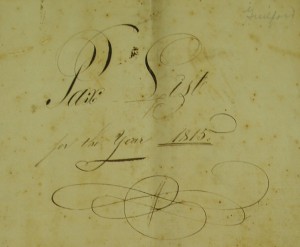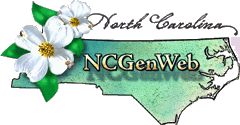Guilford County started administering its territory in 1771, but only two early tax lists have survived. One story or explanation is that courthouse staff would sometimes burn old tax lists in the stove for warmth on cold days, but we also know that the Union Army was in Greensboro for a period of time during the Civil War, and burning courthouse records was a common tactic for invading armies. The British Army burned Guilford Courthouse and many court records at the time of the Battle of Guilford Courthouse in March 1781.
Tax Lists Reflected in Court Records
The surviving court records contain lists of insolvents, notes about individuals who were mistakenly charged twice, residents who were given exemptions or reduced rates due to age, etc., and other unusual situations. Please see the links on the Court Records page.
1813 Tax List
I have photocopies of the 1813 Guilford tax list for Deep River District — regrettably, that district only. I have transcribed the list:
Tax List of 1813
but I hope to obtain the images by the end of 2014.
1815 Tax List
I photographed the 1815 tax list on a visit to the North Carolina State Archives. These images may be downloaded for private use, but I hold the copyright on the images — yes, photographs can be copyrighted — and they may not be re-published in any form, including on the internet, without my consent.
I have compiled an index for this tax list, and it is linked to the Records tab in the menu above. It needs proof-reading, but it is available.
William Perry Johnson published a transcription of the tax list in 1975. Some of the comments he made in his introduction should be of interest to those looking at the list:
The total land area of present-day Guilford is 416,640 acres; approximately 90% of the land (365,490 & 1/2 acres) had been taken up by 1815. But of the approximately 2,173 taxables listed in 1815, around 511, or 23 & 1/2 % (nearly 1/4th owned no land at all).
In 1815 Guilford had 1,563 white poll taxables, and 792 black polls (mostly if not all slaves). Compare with Guilford’s population in 1790: 7,300 (including 616 slaves); and 39,074 in 1900 (27,969 whites, and 11,105 non-whites); and a total population in 1950 of 191,300. In 1815, Guilford’s population was, roughly, upwards of 10,000 whites (men, women, and children), and, perhaps, 3,000 blacks. Of the 2,173 taxables listed in 1815, about 313, nearly 15%, were slaves owners. 67 of the 2,173 were women (a little over 3%); 5 of the 67 were designated as “widow”.
There were three towns in Guilford in 1815: (1) Jamestown–established 1770, and named for James Mendenhall, a Quaker. (2) Martinville–established 1774 as Guilford Courthouse; a courthouse fire in 1781 destroyed many of Guilford’s county records for the 1771-1781 period; the name of Guilford Courthouse was changed in 1785 to Martinville, in honor of Gov. Alexander Martin. Martinville was abandoned in 1808 with the establishment of Greensboro as the county seat. The famous Revolutionary War battle of 15 March 1781 was fought here–the Battle of Guilford Courthouse. The site is now a National Military Park. (3) Greensboro–established 1808 and became the new county seat at that time. It was named for Genl. Nathanael Greene, American leader at the Battle of Guilford Courthouse.
There were 10 stores in Guilford County in 1815: – David Lindsay (p. 1), John Slade (p. 12), James Clemmons (p. 25), Andrew Lindsay (p. 25), Jonathan Gardner (p. 40), A. Gardner (p. 42), Levin Charles (p. 64), Jonathan Parker (p. 65), Zeno Worth (p. 65), and Robert Lindsay (p. 70).
It is unusual that no carriages, or “wheels of pleasure” are given; also, no doctors are listed!
Guilford County in 1815 had 11 men who operated taverns and/or were retailers of spirits: – Robert A. Carson (p. 12), John Slade (p. 12), Thomas Kirkman (p. 12), John Pritchett (p. 12), Aron Walker (p. 17), Jesse Jones (p. 19), Andrew Lindsay (p. 25), Timothy McKeever (p. 37), Risden Charles (p. 62), Robert Lindsay (p. 70), and John Gibson Sr. (p. 71).
Of the 10 stores and 11 taverns, 3 apparently were combinations of store and tavern: John Slade, Andrew Lindsay, and Robert Lindsay.
Horses were the main source and means of power and transportation in North Carolina, as elsewhere, and the breeding of horses was of prime importance. In Guilford in 1815 there were 9 men who offered stud hourses to the public: Nathan Armfield (p. 11), Hezekiah Bevill (p. 18), Jesse Hunt (p. 25), John Dillin [Dillon] (p. 28), Edmond Donnell (p. 32), Arthur Woodbourn (p. 46), James Hendrix (p. 47), John Woodburn (p. 47), and Larkin Wisdom (p. 77).
Guilford’s largest land and/or slave owners in 1815, those, for example, with 1,000 acres or more of land, and more than, say, 6 slaves, are as follows:
Ralph Gorrell (p. 45) – 3,339 a., 5 sl.
John Elliott (p. 74) – 1,960 a., no sl.
Benjamin Shaw (p. 28) – 1,420 a., no sl.
Charles Bruce (p. 3) – 1,396 a., 5 sl.
John Thompson (p. 17) – 1,300 a., 18 sl.
John Cunningham (p. 30) – 1,300 a., 8 sl.
John Hamilton (p. 71) – 1,291 a., 8 sl.
Major Robert Donnell (p. 32) – 1,218 a., 7 sl.
James Dick (p. 52) – 1,193 a., 7 sl.
John Stewart (p. 46) – 1,180 a., 5 sl.
Robert Lindsay (p. 70) – 1,100 a., 7 sl.
Robert Bell (p. 24) – 1,093 a., 2 sl.
John Donnell (p. 35) – 1,086 a., 1 sl.
William Welch (p. 60) – 1,022 a., no sl.
James Davis (p. 21) – 1,000 a., no sl.
Thomas Dick (p. 23) – 1,000 a., 12 sl.
John Boon Sr. (p. 50) – 300 a., 7 sl.
Colo. Samuel Hunter (P. 18) – 403 a., 7 sl.
Unusual names were few: Little William Hunt, Billy Brown, Uncle Abel Knight.
[County Coordinator wonders how he missed the name of Sharp Blunt on page 3!]
The above paragraphs in italics are quoted from William Perry Johnson’s private publication of the 1815 tax list; the copyright is owned by his heirs. This information is made available strictly for private use and is not for republication in any form.




